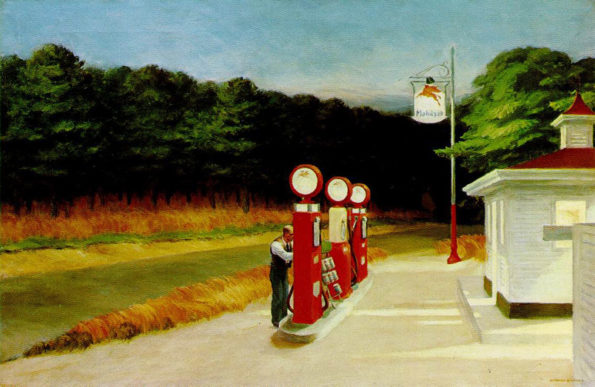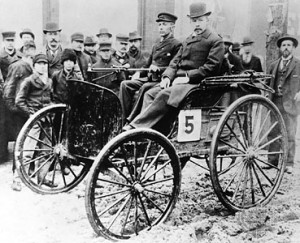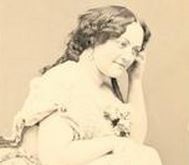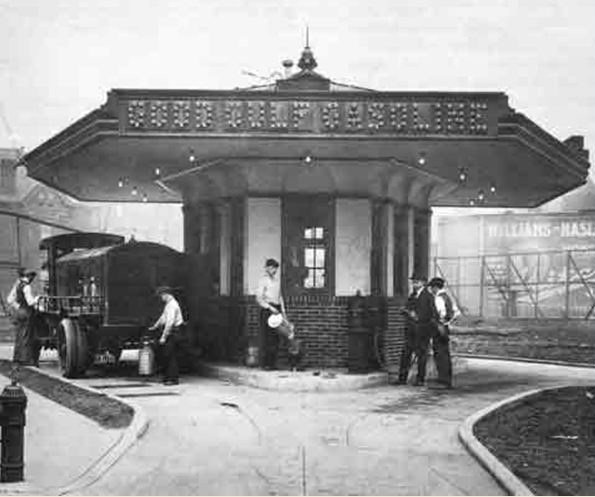November 27, 1940 – Art Museum features Painting of Mobilgas Station –
With petroleum company service stations already part of America’s popular culture, Edward Hopper’s painting “Gas” was first exhibited by the Whitney Museum of American Art in New York City. Art critics praised the work, suggesting the painting with the Pegasus sign anticipated the modern Pop Art movement by more than a decade.

Edward Hopper (1882-1967) oil on canvas painting “Gas” of 1940. Museum of Modern Art, New York.
According to Hopper’s wife, the image of a Mobilgas station at the end of a highway was an amalgamation of several gas stations near their home in Truro, Massachusetts. The painting is owned by the Museum of Modern Art in New York City.
See other examples of petroleum’s artistic influence in Oil In Art.
November 27, 1941 – “Oil Queen of California” dies
Mrs. Emma Summers, once known as the “Oil Queen of California” died at the age of 83 in Los Angeles. Forty years earlier, the San Francisco Call newspaper described Mrs. Summers as “A woman with a genius for affairs — it may sound paradoxical, but the fact exists. if Mrs. Emma A. Summers were less than a genius she could not, as she does today, control the Los Angeles oil markets.”

Newspapers featured Emma Summers as she succeeded in the fiercely competitive Los Angeles oilfields of the early 1900s.
Summers graduated from Boston’s New England Conservatory of Music and moved to Los Angeles in 1893 to teach piano — but soon caught oil fever. With her home not far from where Edward Doheny had discovered the Los Angeles City field just a year before, Summers invested $700 for half interest in a well just a few blocks from Doheny’s. Summers’ first 14 wells produced oil, helping launch her dominance in the Los Angeles City oilfield.
Learn more about this remarkable woman in Oil Queen of California.
November 27, 1923 – Standard Oil registers “Esso” Trademark
The Standard Oil Company of New Jersey registered the “Esso” trademark, which had been in use since May 1923 for refined, semi-refined, and unrefined petroleum products. The name was a phonetic spelling of the abbreviation “S.O.” for Standard Oil.
A young Theodore Geisell created many Essolube ads beginning in the 1930s (see Seuss I am, an Oilman). When Standard Oil renamed itself Exxon in 1973, the company adopted the Exxon trademark nationwide. The Esso name, acquired by BP through various mergers, has remained in use in other countries.
November 28, 1895 – Inventor Duryea wins First U.S. Auto Race
Six of America’s first “motor cars” left Chicago’s Jackson Park for a 54-mile race to Evanston, Illinois, and back through the snow. Inventor J. Frank Duryea received $2,000 for winning the first U.S. auto race. His No. 5 automobile took just over 10 hours at an average speed of about 7.3 mph.

J. Frank Duryea and his brother Charles invented America’s first gas-powered automobile. Photo courtesy Library of Congress.
The Chicago Times-Herald, sponsor of the race, also awarded $500 for a racing enthusiast’s “motocycle.” The newspaper added: “Persons who are inclined to decry the development of the horseless carriage will be forced to recognize it as an admitted mechanical achievement, highly adapted to some of the most urgent needs of our civilization.” Within five years, New York City would host the first U.S. auto show.
November 28, 1892 – First Kansas Oil Well
While drilling for natural gas, William Mills discovered small amounts of oil in eastern Kansas. He took a sample from his Norman No. 1 well and visited experienced oil drillers in Pennsylvania. Impressed, they convinced him to “shoot” the well at Neodesha with 30 quarts of nitroglycerine.

A rare photograph of the 1897 Standard Oil refinery in Neodesha, Kansas, the first to process oil from the Mid-Continent field. Photo courtesy Kansas Historical Society.
The Kansas oil well was the first to find commercial success drilling west of the Mississippi River. “It proved that Neodesha had the riches of oil and gas in their back yard,” according to Neodesha’s Norman No. 1 Historic Oil Well and Museum.
Just 832 feet deep, the discovery well uncovered the vast Mid-Continent producing region, eventually including five states. Abandoned in 1919, the discovery well was neglected until 1961, when a replica 67-foot wooden derrick was erected on the site as a memorial.
Learn more in First Kansas Oil Well.
November 29, 1927 – Patent awarded for Coin-Operated Gas Pump
Lewis P. Starkey, of Fort Collins, Colorado, received a U.S. patent for his “Self Operating Filling Station,” an electrically powered coin-operated device for dispensing gasoline. The L.P. Starkey Pump Company competed with other manufacturers of automatic pumps that did not need an attendant.
Earlier self-service “gasoline slot machines” had required motorists to insert a coin into a slot and turn a crank.

Detail from the “Self-Operating Filling Station,” patented by Lewis Starkey of Fort Collins, Colorado, in 1927.
The L.P. Starkey Pump Company would be acquired by Gas-O-Mat Inc. of Denver, which produced two models of Starkey’s coin-operated pumps.
Learn more in Coin-Operated Gas Pumps.
December 1, 1865 – Lady Macbeth arrives at Famous Boom Town
Shakespearean tragedienne Miss Eloise Bridges appeared as Lady Macbeth at the Murphy Theater in Pithole, Pennsylvania, America’s first famously notorious oil boom town. A January 1865 oilfield discovery had launched the drilling frenzy that created Pithole, which within a year had 57 hotels, a daily newspaper and the third busiest post office in Pennsylvania.

Star of the stage in boom town Pithole, Pennsylvania, Eloise Bridges, circa 1865.
Bridges appeared at Murphy’s Theater, the biggest building in a town of more than 30,000 teamsters, coopers, lease-traders, roughnecks, and merchants. Three-stories high, the building included 1,100 seats, a 40-foot stage, an orchestra, and chandelier lighting by Tiffany.
Bridges was the acclaimed darling of the Pithole stage. Eight months after she departed for new engagements in Ohio, Pithole’s oil ran out; the most famous U.S. boom town collapsed into empty streets and abandoned buildings. Today, visitors can walk the grass streets of the historic ghost town.
Learn more in Oil Boom at Pithole Creek.
December 1, 1901 – Indian Territory Illuminating Oil Company organized
With almost 1.5 million acres of Osage Indian Reservation under a 10-year lease expiring in 1906, Henry Foster organized the Indian Territory Illuminating Oil Company by combining the Phoenix Oil Company and Osage Oil Company. The lease provided the Osage with a 10 percent royalty on oil produced and $50 per year for each natural gas well. Foster subleased drilling to 75 different companies, but only 30 wells were drilled in 1903.
Although debt would drive the Indian Territory Illuminating Oil Company into receivership, the company emerged thanks to partnering with Theodore Barnsdall, who helped Foster complete 361 oil and gas wells by the end of 1904. Foster became known as “the richest man west of the Mississippi” and Barnsdall’s interests were sold to a Cities Service Company subsidiary for $40 million in 1912.
Learn more in First Oklahoma Oil Well.
December 1, 1913 – First U.S. Drive-In Service Station opens in Pittsburgh
“Good Gulf Gasoline” was sold when Gulf Refining Company opened America’s first drive-in service station at the corner of Baum Boulevard and St. Clair Street in Pittsburgh, Pennsylvania.
Unlike earlier simple curbside gasoline filling stations, the purposefully designed pagoda-style brick facility offered free air, water, crankcase service, and tire and tube installation. A manager and four attendants stood nearby. The service station’s lighted marquee provided shelter from bad weather.

Gulf Refining Company opened the first service station (above) in 1913 on “automobile row,” Baum Boulevard in Pittsburgh. Photo courtesy Gulf Oil Historical Society.
“On its first day, the station sold 30 gallons of gasoline at 27 cents per gallon. On its first Saturday, Gulf’s new service station pumped 350 gallons of gasoline,” according to the Pennsylvania Historical and Museum Commission. “Prior to the construction of the first Gulf station in Pittsburgh and the countless filling stations that followed throughout the United States, automobile drivers pulled into almost any old general or hardware store, or even blacksmith shops in order to fill up their tanks.”
When the station was opened in 1913, Baum Boulevard had become known as “automobile row” because of the many dealerships located along the thoroughfare. In addition to gas, the Gulf station provided free air and water — and sold the first commercial road maps in the United States.
Learn more in First Gas Pump and Service Station.
December 1, 1960 – Lucy’s Broadway Oil Musical
Lucille Ball debuted in “Wildcat,” her first and last foray onto Broadway. Critics loved Lucy — but hated the show. She played the penniless “Wildcat Jackson” scrambling to find an oil gusher in a dusty Texas border town, circa 1912.

Oil gushers featured on album cover of 1960 Broadway musical “Wildcat.”
“Wildcat went prospecting for Broadway oil but drilled a dry hole,” proclaimed a New York Times critic. Although some audiences appreciated a rare oil patch musical, after 171 performances, the show closed.
December 2, 1942 – Roosevelt centralizes Petroleum Management for War Effort
President Franklin D. Roosevelt established by executive order the Petroleum Administration for War, “for the successful prosecution of the war and other essential purposes.” The program had begun in June 1941, when petroleum industry leaders were invited to Washington to meet with Secretary of Interior Harold L. Ickes, head of the newly created Office of Petroleum Coordinator for National Defense.
“The oilmen, most of whom later acknowledged that they had been fearful of some new and far-reaching measures of Federal control, were told by the Coordinator and the Deputy Coordinator that all that was wanted of them was cooperation in what was then a vast and growing national defense effort, later to become a prodigious war job,” explained the 2005 book, History of the Petroleum Administration for War, 1941-1945. Roosevelt ended the Petroleum Administration for War in May 1946.
December 2, 2001 – Enron Corporation files for Bankruptcy
Enron, once the world’s largest energy-trading company, filed for Chapter 11 bankruptcy protection, beginning one of the largest corporate scandals in U.S. history. The Houston-based company had reached a market value of almost $70 billion before it collapsed, causing thousands of employees to lose their jobs and more than $2 billion in pensions.
In 2006, former Enron Chairman and CEO Kenneth Lay and former Chief Operating Officer Jeffrey Skilling were tried in federal district court. The jury convicted both executives of multiple counts of securities and wire fraud. New state and federal accounting regulations resulted from the scandal.
December 2, 1970 – Nixon establishes Environmental Protection Agency
Eleven months after the 1969 offshore platform oil spill at Santa Barbara, California, President Richard M. Nixon established the U.S. Environmental Protection Agency.

The new agency consolidated “a variety of federal research, monitoring, standard-setting and enforcement activities to ensure environmental protection.” Assistant Attorney General William Ruckelshaus was named the agency’s first administrator.
According to an EPA history, newly proposed environmental initiatives included improvement of water treatment facilities; creation of national air quality standards; stringent guidelines to lower motor vehicle emissions; a clean-up of federal facilities; tightening of safeguards on the seaborne transportation of oil; and a proposed tax on lead additives in gasoline.
_______________________
Recommended Reading: America’s First Automobile: The First Complete Account By Mr. J. Frank Duryea Of How He Developed The First American Automobile, 1892-1893 (2012); The fire in the rock: A history of the oil and gas industry in Kansas, 1855-1976 (1976); Cherry Run Valley: Plumer, Pithole, and Oil City, Pennsylvania, Images of America
(2000); Fill’er Up!: The Great American Gas Station
(2013); History of the Petroleum Administration for War, 1941-1945 (2005). Your Amazon purchase benefits the American Oil & Gas Historical Society. As an Amazon Associate, AOGHS earns a commission from qualifying purchases.
_______________________
The American Oil & Gas Historical Society (AOGHS) preserves U.S. petroleum history. Become an AOGHS annual supporting member and help maintain this energy education website and expand historical research. For more information, contact bawells@aoghs.org. Copyright © 2023 Bruce A. Wells. All rights reserved.


